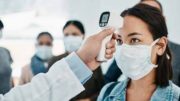
A range of new research on face coverings shows that the risk of infection to the wearer of the face mask is decreased by 65%, said Dean Blumberg, chief of pediatric infectious diseases at UC Davis Children’s Hospital and William Ristenpart, professor of chemical engineering at UC Davis.
“On the issue of masks, I’d like to restart — because we’ve learned a lot,” Blumberg said. “We’ve learned more due to research and additional scientific evidence. What we know now is that masks work and are very important.”
“There are two primary methods of transmission, they said. The first is via droplets a carrier expels, which are about one-third the size of a human hair but still large enough that we can see them. Masks create an effective barrier against droplets.
“People who don’t wear a mask increase the risk of transmission to everyone, not just the people they come into contact with. It’s all the people those people will have contact with. You’re being an irresponsible member of the community if you’re not wearing a mask.”
“…The second major transmission method is via the aerosol particles we expel when we talk. Those are about 1/100th the size of a human hair and are more difficult to defend against.
“Studies in laboratory conditions now show the virus stays alive in aerosol form with a half-life on the scale of hours. It persists in the air,” Ristenpart said.
Additionally, time of exposure matters. Ristenpart said that, “It’s really important to know that just because you’re standing 6 feet or 7 feet away, if you have a prolonged conversation, there is still a risk. These aerosols can be carried along on weak air currents…”




